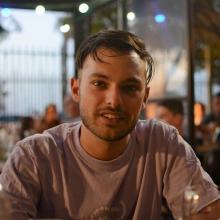Evolution, Behaviour, Adaptation Group
Members

Maîtresse de conférences
UCBL
Tel: 33 04 72 43 26 33

Assistant ingénieur CDD
CNRS
Tel: 04 72 44 81 42
Doctorante
CNRS

Professeure des universités
VetAgro-Sup
Tel: 04 78 87 25 71
Maîtresse de conférences
UCBL
Tel: 04 72 44 80 67

Professeur des universités
UCBL
Tel: 33 04 72 43 26 33

Directrice de recherche
CNRS
Tel: 33 04 72 43 14 04

Chargée de recherche
CNRS
Tel: 04 72 44 81 42

Maître de conférences
UCBL
Tel: 33 04 72 43 13 37

Maîtresse de conférences
UCBL
Tel: 04 72 43 12 86

Directrice de recherche
CNRS
Tel: 33 04 72 43 29 10

Doctorant
UCBL
Tel: 04 72 44 81 42
Doctorante
UCBL

Professeur des universités
UCBL
Tel: 33 04 72 43 29 03
Directeur de recherche
CNRS
Tel: 04 72 44 81 42

Maître de conférences
UCBL
Tel: 33 04 72 43 27 85

Post-doc
UCBL
The Evolution, Adaptation and Behavior group aims at studying the evolution of phenotypic and behavioral traits through a combination of long-term monitoring of natural populations, of field and lab experiments, of molecular analyses, and of mathematical and computational modeling. Our research mainly focuses on animals, in particular mammals (alpine marmot, giraffe), birds (white-throated dipper, collared flycatcher, great tit) and insects (various Drosophila species, the parasitoid wasp Venturia canescens).
We study the evolution of fitness-related traits in interaction, either selective or plastic, with an individual’s biotic and abiotic environment. Interactions between individuals have a special importance in our reasoning and are thus the object of a first axis of research on group dynamics and social interactions. We also consider the environment as providing resources and informative signals through two other axes, one on phenotypic plasticity and the other on resource allocation and the sensitivity to environmental variables. In both, we consider the impact of stress factors caused by human activities — such as global warming, artificial lighting or invading species — or by the presence of pathogens.
Group dynamics and social interaction. The environment encountered by numerous animals contains, on top of resources and other elements, other individuals. Social interactions vary immensely between species, from a solitary lifestyle to such an extreme degree of cooperation that a part of the group sacrifices their reproduction at the benefit of others, specialized in this task. In this axis, we try to understand how groups form and how social structures are maintained, at various scales extending from unicellular organisms to cooperative mammals.
Here are a few examples of questions that we address:
- Evolution of sociality: what are the consequences of climate change on the benefits of group living (in the alpine marmot)? How does that impact group composition and the probability and age of dispersal?
- Group dynamics: how does the size and composition of familial groups evolve in the context of climate change? In giraffes, how do temporary groups form, and what role do kinship play in the probability and duration of pairing?
- Which evolutionary trajectories have led to multicellular organisms expressing differentiated cell types, a part of which sacrifice their reproduction?
- What are the neurogenomic determinants that signal the presence of related individuals in solitary individuals, triggering altruistic behaviors?
Phenotypic plasticity. Evolution by natural selection can drive phenotype changes on short timescales, in the order of a few generations. Yet it remains inefficient to track more frequent environmental changes. Phenotypic plasticity is a means to buffer such environmental variations, either through informed decisions or fixed reaction norms, which are the object of study in this axis.
Here are a few examples of questions that we address:
- How do individual characteristics, in particular personality traits, shape the use of information on the environment for decision-making?
- Is there a trade-off between the speed of decision making and its accuracy? What conditions favor genotypes that make fast, error-prone decisions, or slower, more accurate genotypes?
- What types of environmental variations select for plastic genotypes?
- Do changes in gene expression observed during environmental fluctuations induce behavioral changes?
Resource allocation and sensitivity to environmental variables. Organisms make other decisions throughout their lives as they decide how much resources to allocate to various traits, such as survival, growth, reproduction or immunity. This differential allocation of resources relies on complex systems, or instance the endocrine system in animals, that we study. These systems can be disturbed by anthropogenic changes that disrupt the long-term ecological setting in which they have evolves, resulting in major phenotype perturbations.
Here are a few examples of questions that we address:
- How do endocrine systems — that allow the communication between tissues and control the differential allocation of resources — evolve?
- How do chemical pollutants affect physiological processes, ageing and thereby life-history strategies in response to environmental variation?
- What role do climatic fluctuations play in the heterogeneity of parasite infection, especially at stages that go through the external environment?
Publications
Display of 391 to 420 publications on 455 in total
Energy dynamics in a parasitoid foraging in the wild
Journal of Animal Ecology . 72 : 691-697
Journal article
see the publicationDispersal between host populations in field conditions: navigation rules in the parasitoid Venturia canescens
Ecological Entomology . 28 : 257-267
Journal article
see the publicationWhen to use public information for breeding habitat selection? The role of environmental predictability and density dependence
Animal Behaviour . 66 : 973-988
Journal article
see the publicationGathering public information and habitat selection: prospecting birds cue on parental activity
Proceedings of the Royal Society B: Biological Sciences . 270 : 1809-1813
Journal article
see the publicationMicrospatial structure of Drosophila melanogaster populations in Brazzaville: evidence of natural selection acting on morphometrical traits
Heredity . 91 : 440-447
Journal article
see the publicationGenetic variability of sexual size dimorphism in a natural population of Drosophila melanogaster: an isofemale-line approach
Journal of Genetics . 82 ( 3 ) : 79-88
DOI: 10.1007/BF02715810
Journal article
see the publicationMorphometrical evolution in a Drosophila clade: the Drosophila obscura group
Journal of Zoological Systematics and Evolutionary Research . 41 : 64-71
Journal article
see the publicationThe fly that came in from the cold: geographic variation of recovery time from low-temperature exposure in Drosophila subobscura
Functional Ecology . 17 : 425-430
Journal article
see the publicationEvolution of reaction norms In Phenotypic plasticity : functional and conceptual approaches
incollection . 4 : 50-63
Journal article
see the publicationBet-hedging for variability in life cycle duration: bigger and later-emerging chestnut weevils have increased probability of a prolonged diapause
Oecologia . 132 : 167-174
Journal article
see the publicationIntraspecific competition between healthy and parasitized hosts in a host parasitoid system: consequences for life-history traits.
Ecological Entomology . 27 : 415-423
Journal article
see the publicationCosts of reproduction: assessing responses to brood size manipulation on life-history and behavioural traits using multi-state capture-recapture models
Journal of Applied Statistics . 29 : 407-423
Journal article
see the publicationVariable modes of inheritance of morphometrical traits in hybrids between Drosophila melanogaster and Drosophila simulans
Proceedings of the Royal Society B: Biological Sciences . 269 : 127-135
Journal article
see the publicationResource limitation in natural populations of phytophagous insects. A long-term study case with the chestnut weevil
Acta Oecologica . 23 : 31-39
Journal article
see the publicationGeographic distribution of Triatoma dimidiata and transmission dynamics of Trypanosoma cruzi in the Yucatan peninsula Mexico
American Journal of Tropical Medicine and Hygiene . 67 : 176-183
Journal article
see the publicationPublic information and breeding habitat selection in a wild bird population
Science . 297 : 1168-1170
Journal article
see the publicationMale sterility thermal threshold in Drosophila: D. simulans appears more cold-adapted than its sibling D. melanogaster
Genetica . 114 : 195-205
Journal article
see the publicationPhenotypic plasticity of adult size and pigmentation in Drosophila : thermosensitive periods during development in two sibling species
Journal of Thermal Biology . 26 : 351-361
Journal article
see the publicationPhenotypic plasticity of body pigmentation in Drosophila: influence of a developmental thermoperiodic regime in two sibling species
Physiological Entomology . 27 : 124-135
Journal article
see the publicationCHILL-COMA TOLERANCE, A MAJOR CLIMATIC ADAPTATION AMONG DROSOPHILA SPECIES
Evolution - International Journal of Organic Evolution . 55 ( 5 ) : 1063-1068
Journal article
see the publicationLOCOMOTOR PERFORMANCE OF DROSOPHILA MELANOGASTER: INTERACTIONS AMONG DEVELOPMENTAL AND ADULT TEMPERATURES, AGE, AND GEOGRAPHY
Evolution - International Journal of Organic Evolution . 55 ( 1 ) : 205-209
Journal article
see the publicationLocomotor performance of Drosophila melanogaster: interactions among developmental and adult temperatures age and geography
Evolution - International Journal of Organic Evolution . 55 : 205-209
Journal article
see the publicationChill-coma temperature in Drosophila: effects of developmental temperature latitude and phylogeny
Physiological and Biochemical Zoology . 74 : 429-434
Journal article
see the publicationPhenotypic plasticity of body size in Drosophila: effects of a daily periodicity of growth temperature in two sibling species
Physiological Entomology . 26 : 351-361
Journal article
see the publicationThe stength of phenotypic selection in natural population
The American Naturalist . 157 : 245-261
Journal article
see the publicationChill coma tolerance: a major climatic adaptation among Drosophila species
Evolution - International Journal of Organic Evolution . 55 : 1063-1068
Journal article
see the publicationPublic information and breeding habitat selection
incollection . -- : 243-258
Journal article
see the publicationViability and rate of development at different temperatures in Drosophila: a comparison of constant and alternating thermal regimes
Journal of Thermal Biology . 26 : 29-39
Journal article
see the publicationTemperature dependence rate of developmental rate and adult size in Drosophila species: biophysical parameters
Journal of Evolutionary Biology . 14 : 267-276
Journal article
see the publicationClutch size manipulations in the chestnut weevil Curculio elephas: fitness of oviposition strategy
Oecologia . 122 : 493-499
Journal article
see the publication
You also, comment on this article